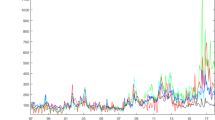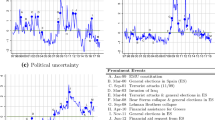Abstract
Empirical work on uncertainty and investment generally focuses on one country or one indicator of uncertainty. We extend the literature by assessing the impact of a comprehensive range of potential sources of uncertainty on aggregate business investment across the G7 using Pooled Mean Group Estimation (PMGE) and GARCH methods to model uncertainty. A significant negative long-run effect from exchange rate volatility is found for the G7 and in poolable subgroups including all four larger EU countries. Volatility of long-term interest rates has additionally influenced investment in recent years. For most estimates, a one standard deviation rise in conditional volatility leads to a 2–4 per cent fall in investment although some samples give greater declines. The results suggest inter alia that EMU is beneficial to aggregate investment.
Similar content being viewed by others
References
Abel, A. (1983). Optimal Investment under Uncertainty. American Economic Review 73 (1): 228–233.
Abel, A., A. Dixit, J. C. Eberly, and R. S. Pindyck (1996). Options, the Value of Capital and Investment. Quarterly Journal of Economics 111 (3): 753–777.
Ashworth, P., and E. P. Davis (2001). Some Evidence on Financial Factors in the Determination of Aggregate Business Investment for the G7 Countries. NIESR Discussion Paper 187. National Institute of Economic and Social Research, London.
Bean, C. (1981). An Econometric Model of Manufacturing Investment in the UK. Economic Journal 91 (361): 106–121.
Bollerslev, T. (1986). Generalized Autoregressive Conditional Heteroskedasticity. Journal of Econometrics 31 (3): 307–327.
Bollerslev, T., R. Y. Chou, and K. F. Kroner (1992). ARCH Modelling in Finance. Journal of Econometrics 52 (1–2): 5–59.
Byrne, J. P., and E. P. Davis (2002). Investment and Uncertainty in the G7. NIESR Discussion Paper 198. National Institute of Economic and Social Research, London.
Byrne, J. P., and E. J. Davis (2003a). Panel Estimation of the Impact of Exchange Rate Uncertainty on Investment in the Major Industrial Countries. NIESR Discussion Paper 208. National Institute of Economic and Social Research, London.
Byrne, J. P., and E. P. Davis (2003b). Financial Structure. Cambridge: Cambridge University Press.
Caballero, R. (1999). Aggregate Investment. In J. B. Taylor and M. Woodford (eds.), Handbook of Macroeconomics. Vol. 1. Amsterdam: Elsevier Science.
Campa, J. M., and L. S. Goldberg (1995). Investment in Manufacturing, Exchange Rates and External Exposure. Journal of International Economics 38 (3–4): 297–320.
Carruth, A., A. Dickerson, and A. Henley (2000a). Econometric Modelling of UK Aggregate Investment: The Role of Profits and Uncertainty. The Manchester School 68 (3): 276–300.
Carruth, A., A. Dickerson, and A. Henley (2000b). What Do We Know about Investment under Uncertainty? Journal of Economic Surveys 14 (2): 119–153.
Chirinko, R. (1993). Business Fixed Investment Spending: Modelling Strategies, Empirical Results, and Policy Implications. Journal of Economic Literature 31 (4): 1875–1911.
Cooper, R., and J. Ejarque (2001). Exhuming Q: Market Power versus Capital Market Imperfections. NBER Working Paper 8182. National Bureau of Economic Research, Cambridge, Mass.
Cuthbertson, K., and D. Gasparro (1995). Fixed Investment Decisions in UK Manufacturing: The Importance of Tobin’s Q, Output and Debt. European Economic Review 39 (5): 919–941.
Darby, J., A. Hughes Hallett, J. Ireland, and L. Piscatelli (1999). The Impact of Exchange Rate Uncertainty on the Level of Investment. Economic Journal 109 (454): C55–C67.
Davis, E. P., and J. Madsen (2001). Productivity and Equity Returns: A Century of Evidence for 9 OECD Countries. Working Paper 01-12. Brunel University Department of Economics and Finance.
Dixit, A., and R. S. Pindyck (1994). Investment under Uncertainty. Princeton: Princeton University Press.
Driver, C., and D. Moreton (1991). The Influence of Uncertainty on Aggregate Spending. Economic Journal 101 (409): 1452–1459.
Driver, C., P. Yip, and N. Dakhil (1996). Large Company Capital Formation and Effects of Market Share Turbulence: Micro-Data Evidence from the PIMS Database. Applied Economics 28 (6): 641–651.
Engle, R. F. (1983). Estimates of the Variance of US Inflation Based upon the ARCH Model. Journal of Money, Credit and Banking 15 (3): 286–301.
Ferderer, J. P. (1993). The Impact of Uncertainty on Aggregate Investment Spending: An Empirical Analysis. Journal of Money, Credit and Banking 25 (1): 30–48.
Goldberg, L. S. (1993). Exchange Rates and Investment in United States Industry. Review of Economics and Statistics 75 (4): 575–589.
Guiso, L., and G. Parigi (1999). Investment and Demand Uncertainty. Quarterly Journal of Economics 114 (1): 187–227.
Hartman, R. (1972). The Effect of Price and Cost Uncertainty on Investment. Journal of Economic Theory 5 (2): 258–266.
Hsiao, C. (2003). Analysis of Panel Data. 2nd Edition. Cambridge: Cambridge University Press.
Huizinga, H. (1993). Inflation Uncertainty, Relative Price Uncertainty and Investment in US Manufacturing. Journal of Money, Credit and Banking 25 (3): 521–554.
Jones, C. (1995). Time Series Tests of Endogenous Growth Models. Quarterly Journal of Economics 110 (2): 495–525.
Jorgensen, D. W. (1963). Capital Theory and Investment Behaviour. American Economic Review 53 (2): 247–259.
Kenen, P., and D. Rodrick (1986). Measuring and Analyzing the Effects of Short-Term Volatility in Real Exchange Rates. Review of Economics and Statistics 68 (2): 311–319.
Knight, F. H. (1921). Risk, Uncertainty and Profit. Boston: Houghton Miftlin.
Kurz, M., and M. Motolese (2001). Endogenous Uncertainty and Market Volatility. Economic Theory 17 (3): 497–544.
Leahy, J., and T. Whited (1996). The Effects of Uncertainty on Investment: Some Stylised Facts. Journal of Money, Credit and Banking 28 (1): 64–83.
Lee, J., and K. Shin (2000). The Role of Variable Input in the Relationship Between Investment and Uncertainty. American Economic Review 90 (3): 667–680.
Lee, K., M. H. Pesaran, and R. Smith (1997). Growth and Convergence in a Multi-Country Empirical Stochastic Solow Model. Journal of Applied Econometrics 12 (4): 357–392.
Ng, S., and P. Perron (2001). Lag Length Selection and the Construction of Unit Root Tests with Good Size and Power. Econometrica 69 (6): 1519–1554.
Pesaran, M. H., and Y. Shin (1998). An Autoregressive Distributed-Lag Modelling Approach to Cointegration Analysis. In S. Strøm (ed.), Econometrics and Economic Theory in the 20th Century: The Ragnar Frisch Centennial Symposium. Cambridge: Cambridge University Press.
Pesaran, M. H., and R. Smith (1995). Estimating Long-Run Relationships from Dynamic Heterogeneous Panels. Journal of Econometrics 68 (1): 79–113.
Pesaran, M. H., R. Smith, and K. S. Im (1996). Dynamic Linear Models for Heterogeneous Panels. In L. Matyas and P. Sevestre (eds.), The Econometrics of Panel Data. Dordrecht: Kluwer.
Pesaran, M. H., Y. Shin, and R. Smith (1999). Pooled Mean Group Estimation of Dynamic Heterogeneous Panels. Journal of American Statistical Association 94 (446): 621–634.
Pindyck, R. S., and A. Solimano (1993). Economic Instability and Aggregate Investment. NBER Macroeconomics Annual 8: 259–303.
Price, S. (1995). Aggregate Uncertainty, Capacity Utilization and Manufacturing Investment. Applied Economics 27 (2): 147–154.
Sensenbrenner, G. (1991). Aggregate Investment, the Stock Market, and the Q Model—Robust Results for Six OECD Countries. European Economic Review 35 (4): 769–825.
Serven, L. (2003). Real Exchange Rate Uncertainty and Private Investment in Developing Countries. Review of Economics and Statistics 85 (1): 212–217.
Shafer, J. R. (1986). Managing Crises in the Emerging Financial Landscape. OECD Economic Studies 8: 56–77.
Temple, P., G. Urga, and C. Driver (2001). The Influence of Uncertainty on Investment in the UK: A Macro or Micro Phenomenon? Scottish Journal of Political Economy 48 (4): 361–382.
Tobin, J. (1969). A General Equilibrium Approach to Monetary Theory. Journal of Money, Credit and Banking 1 (1): 15–29.
Author information
Authors and Affiliations
Corresponding author
Additional information
JEL no.
E22, F31
About this article
Cite this article
Byrne, J., Davis, E. Investment and Uncertainty in the G7. Rev. World Econ. 141, 1–32 (2005). https://doi.org/10.1007/s10290-005-0013-0
Issue Date:
DOI: https://doi.org/10.1007/s10290-005-0013-0




